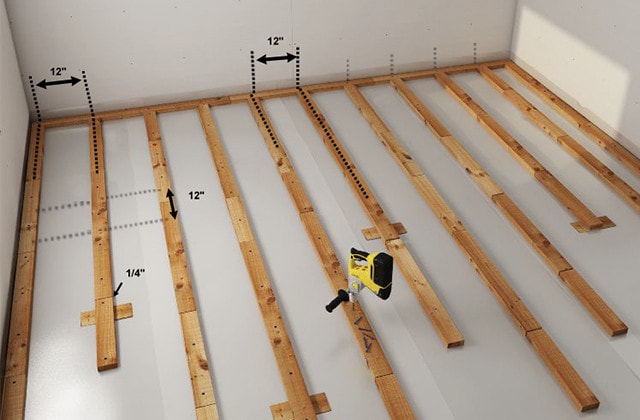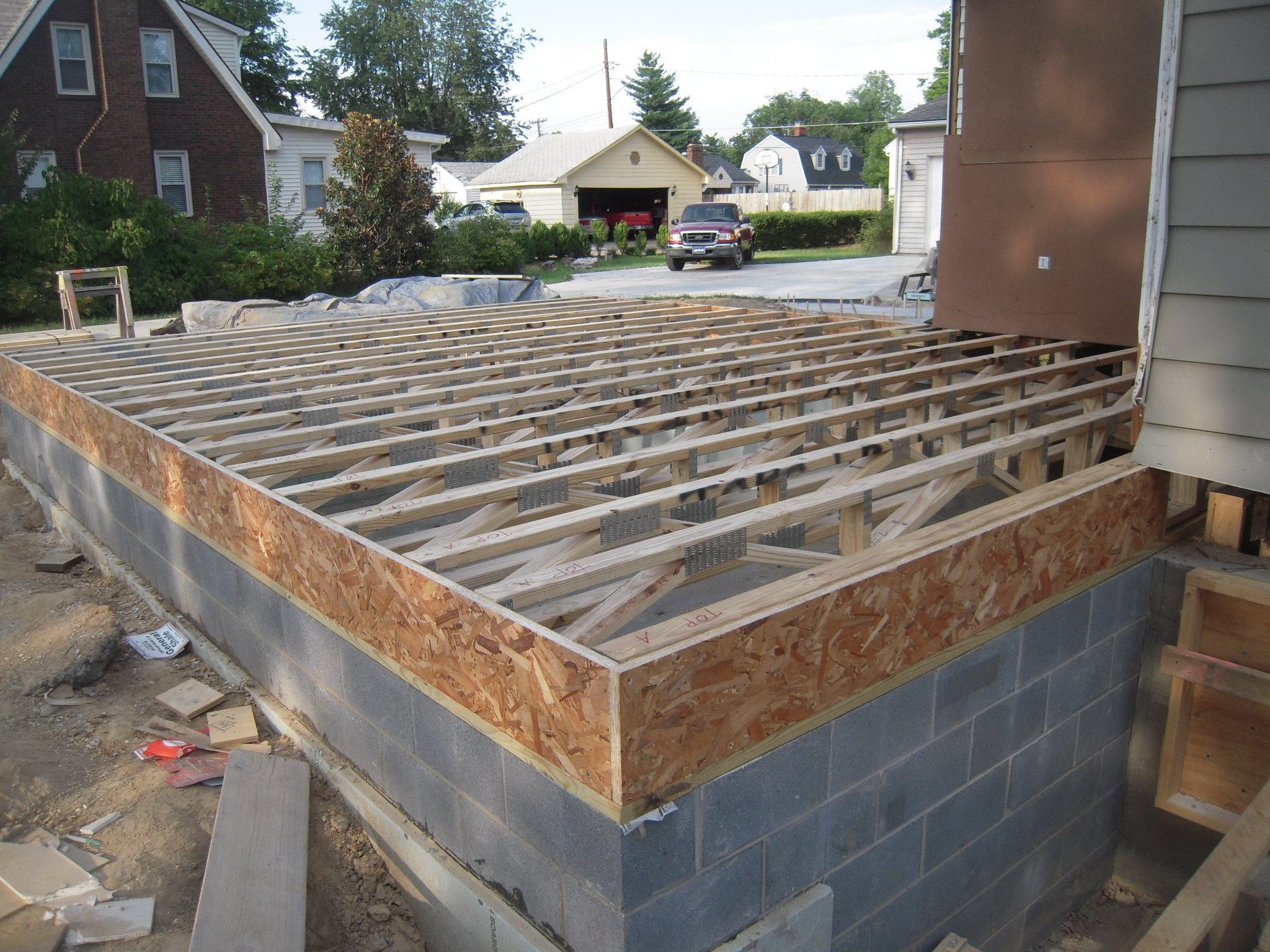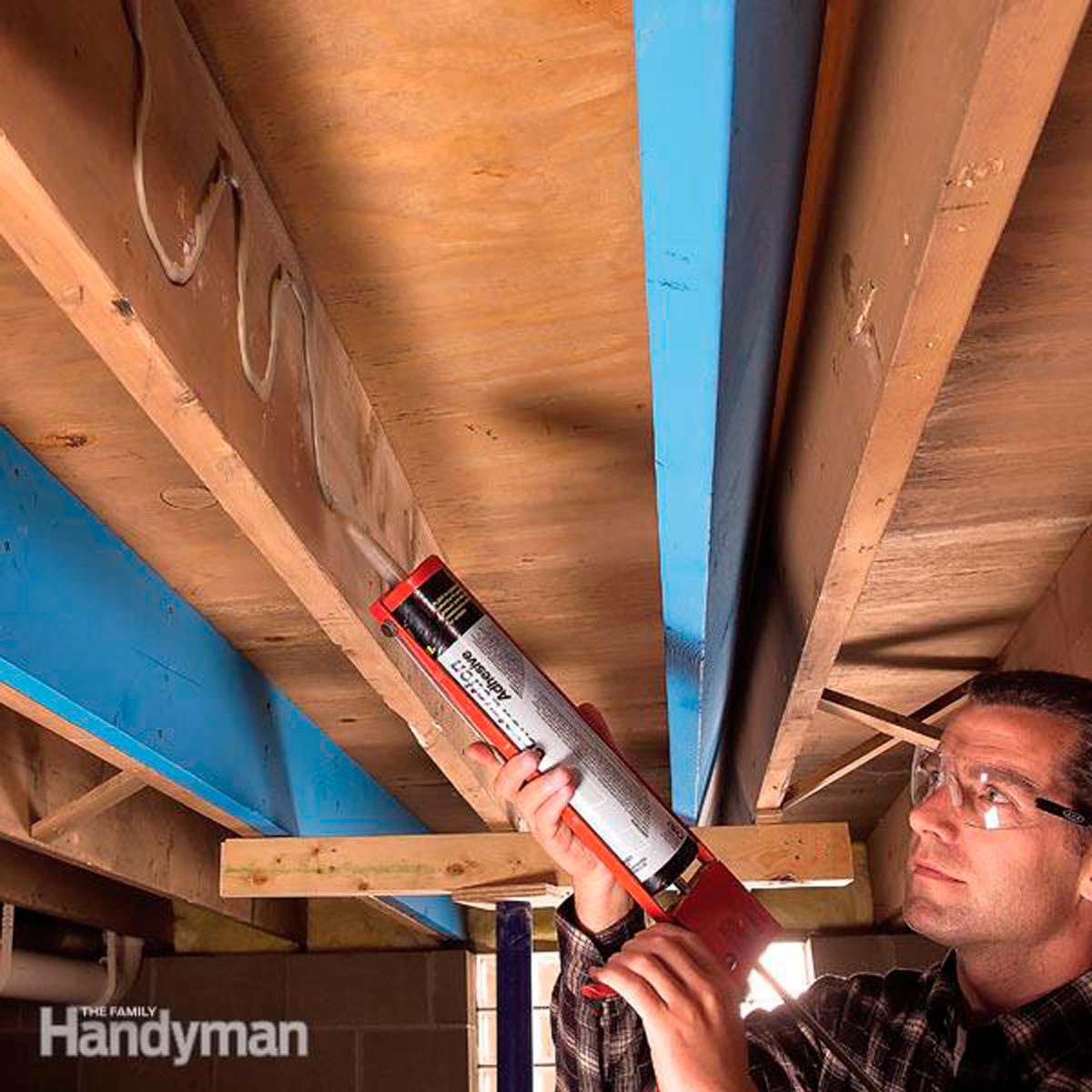Understanding Floor Joists and Their Importance
Floor joists are an essential structural component in any building, providing support for the floors above and distributing the weight of the structure to the foundation. These horizontal beams run parallel to each other and are typically made of wood or steel. Understanding the role of floor joists and their importance is crucial when it comes to constructing a sturdy and stable building, especially when installing them over a basement.
- Supporting the Floors: Floor joists serve as the primary support system for the floors in a building, whether it’s a single-story house or a multi-level structure. They bear the weight of everything above them, including walls, furniture, and occupants, distributing the load evenly to prevent sagging or structural failure.
- Connecting Walls and Floors: Floor joists play a vital role in connecting the walls of a building to the floors, providing a secure attachment point for the framing and ensuring structural stability. They help transfer the weight of the walls to the foundation, preventing any movement or shifting that could compromise the integrity of the structure.
- Creating Open Spaces: Floor joists allow for the creation of open spaces within a building by supporting floor systems without the need for additional support columns or walls. This versatility in design is particularly useful in basements, where homeowners may want to maximize usable space without obstruction from support structures.
- Providing Rigidity and Stability: Properly installed floor joists contribute to the overall rigidity and stability of a building, minimizing any deflection or movement in the floors. This is essential for ensuring a comfortable and safe living environment, as excessive movement or flexing can lead to structural issues and potential hazards.
- Facilitating Insulation and Soundproofing: Floor joists also play a role in insulating the floors and providing soundproofing between levels of a building. By filling the spaces between floor joists with insulation material, homeowners can improve energy efficiency and reduce noise transmission between floors, enhancing overall comfort and livability.
:strip_icc()/sleeper-floor-frame-100424797-aa1a5bda5ed244dd81787ecc855a2160.jpg)
Assessing the Basement and Gathering Materials
Before installing floor joists over a basement, proper preparation is key to ensuring a successful and structurally sound outcome. This involves assessing the basement conditions, gathering the necessary materials and tools, and planning the installation process carefully to avoid any setbacks or complications. Here’s how to prepare for installing floor joists in a basement:
Assessing Basement Conditions: Begin by inspecting the basement to assess its condition and identify any potential issues that may need to be addressed before installing floor joists. Look for signs of moisture, water damage, or structural deficiencies that could affect the stability and integrity of the floor system. It’s essential to address any underlying problems before proceeding with the installation to prevent future issues.
Measuring and Planning: Measure the dimensions of the basement and carefully plan the layout of the floor joists, taking into account factors such as spacing, support points, and load-bearing walls. Consider the intended use of the space and any specific requirements or preferences for the floor system, such as ceiling height or access to utilities.
Gathering Materials and Tools: Once you’ve assessed the basement and planned the installation, gather all the necessary materials and tools for the job. This may include lumber for the floor joists, subflooring material, fasteners, adhesive, and safety equipment such as goggles and gloves. Ensure that you have everything you need before starting the installation to avoid delays or interruptions.
Preparing the Work Area: Clear the basement of any obstacles or debris to create a clean and safe work area for installing the floor joists. Remove any existing flooring materials, such as carpet or tile, and clean the subfloor surface thoroughly to ensure proper adhesion and stability for the new floor system.
Securing Permits and Permissions: Depending on local building codes and regulations, you may need to obtain permits or permissions before installing floor joists in a basement. Check with your local building department to determine the requirements and ensure compliance with all applicable regulations before starting the project.
Organizing Work Crew and Schedule: If you’re working with a team or hiring contractors for the installation, organize the work crew and schedule the project timeline accordingly. Communicate any specific instructions or requirements for the installation process and coordinate tasks to ensure a smooth and efficient workflow.
Step-by-Step Guide to Installing Floor Joists Over a Basement
Installing floor joists over a basement is a crucial step in building a sturdy and stable floor system for the upper levels of a structure. This step-by-step guide outlines the process of installing floor joists in a basement, from preparing the subfloor to securing the joists in place:
Prepare the Subfloor: Begin by preparing the subfloor surface in the basement for the installation of the floor joists. Clean the subfloor thoroughly to remove any debris, dust, or existing flooring materials. Ensure that the subfloor is level and free of any bumps or uneven areas that could affect the stability of the floor system.
Mark Joist Locations: Using a chalk line or other marking tool, mark the locations of the floor joists on the subfloor surface according to the planned layout and spacing. Measure and mark the positions of the joists along the walls and at regular intervals across the basement floor, taking into account any support points or load-bearing walls.
Cut and Install Rim Joists: Cut the rim joists to size based on the dimensions of the basement and the planned layout of the floor joists. Install the rim joists along the perimeter of the basement walls, securing them in place with framing nails or screws. Ensure that the rim joists are level and properly aligned to provide a stable foundation for the floor joists.
Install Floor Joists: With the rim joists in place, begin installing the floor joists according to the marked locations on the subfloor surface. Position each floor joist perpendicular to the rim joists and secure them in place using joist hangers or framing nails. Ensure that the floor joists are spaced evenly and aligned properly to support the intended load.
Secure Joists to Rim Joists: Once all the floor joists are installed, secure them to the rim joists using appropriate fasteners such as nails or screws. Ensure that the floor joists are securely attached to the rim joists to provide structural support and prevent any movement or shifting.
Add Blocking and Bridging: Install blocking or bridging between the floor joists as needed to provide additional support and stability. This helps prevent the floor joists from twisting or sagging under load and ensures a rigid and secure floor system.
Inspect and Reinforce: Once the floor joists are installed, inspect the entire floor system to ensure that all components are properly aligned, secured, and structurally sound. Reinforce any areas that may require additional support or bracing to ensure the stability and integrity of the floor system.
Install Subflooring: After the floor joists are in place, install the subflooring material over the joists to provide a solid and stable surface for the finished flooring material. Secure the subflooring to the floor joists using appropriate fasteners, ensuring a tight and secure fit.
Finish and Seal: Once the subflooring is installed, finish the basement floor according to your preferences and requirements. Apply any necessary sealants or coatings to protect the floor system from moisture and ensure its longevity and durability.
Ensuring Structural Integrity: Tips for Proper Installation
Ensuring the structural integrity of floor joists is crucial for building a sturdy and stable floor system that can support the weight of the structure above and withstand the test of time. Proper installation techniques and adherence to best practices are essential for achieving this goal. Here are some tips for ensuring the structural integrity of floor joists during installation:
Use Quality Materials: Start by using high-quality materials for the construction of floor joists, including lumber that is properly graded and treated for structural use. Choose materials that are resistant to decay, moisture, and pests to ensure the longevity and durability of the floor system.
Follow Building Codes and Regulations: Familiarize yourself with local building codes and regulations governing the installation of floor joists in basements. Ensure that your installation complies with all applicable requirements and standards to ensure the structural integrity and safety of the building.
Proper Spacing and Support: Pay close attention to the spacing and support of floor joists during installation. Follow manufacturer recommendations and building codes for spacing between joists, ensuring adequate support for the intended load. Install additional support beams or columns as needed to distribute weight evenly and prevent sagging or deflection.
Secure Attachment: Properly secure floor joists to rim joists, support beams, and other structural components using appropriate fasteners such as nails or screws. Ensure that all connections are tight and secure to provide maximum structural support and stability.
Use Joist Hangers: Utilize joist hangers or other approved methods for attaching floor joists to rim joists and support beams. Joist hangers provide a secure and reliable connection that helps distribute weight evenly and prevents movement or shifting over time.
Avoid Overloading: Avoid overloading floor joists beyond their intended capacity. Be mindful of the weight of building materials, furniture, and occupants when designing and constructing the floor system to prevent overstressing the joists and compromising their structural integrity.
Proper Bridging and Blocking: Install blocking or bridging between floor joists as needed to provide additional support and stability. This helps prevent twisting or sagging of the joists under load and ensures a rigid and secure floor system.
Inspect Regularly: Regularly inspect the floor joists and the entire floor system for signs of damage, deterioration, or structural issues. Look for cracks, warping, or sagging in the joists, as well as any signs of moisture or pest infestation. Address any issues promptly to prevent further damage and ensure the structural integrity of the floor system.
Common Mistakes to Avoid When Installing Floor Joists in a Basement
Installing floor joists in a basement is a critical step in building a sturdy and stable floor system for the upper levels of a structure. However, several common mistakes can compromise the structural integrity and stability of the floor system if not addressed properly. Here are some common mistakes to avoid when installing floor joists in a basement:
Ignoring Moisture Issues: One of the most common mistakes when installing floor joists in a basement is ignoring moisture issues. Basements are prone to moisture problems, including water infiltration, condensation, and high humidity levels. Failing to address these issues before installing floor joists can lead to mold growth, rot, and structural damage over time.
Improper Spacing and Support: Another common mistake is improper spacing and support of floor joists. It’s essential to follow manufacturer recommendations and building codes for spacing between joists and provide adequate support for the intended load. Failing to do so can result in sagging, deflection, and structural instability of the floor system.
Using Substandard Materials: Using substandard materials for floor joists, such as low-quality lumber or improperly graded wood, is a common mistake that can compromise the structural integrity of the floor system. It’s crucial to use high-quality materials that are properly graded and treated for structural use to ensure the longevity and durability of the floor system.
Poor Attachment and Fastening: Poor attachment and fastening of floor joists to rim joists, support beams, and other structural components is another common mistake to avoid. It’s essential to use appropriate fasteners such as nails or screws and ensure that all connections are tight and secure to provide maximum structural support and stability.
Overloading Floor Joists: Overloading floor joists beyond their intended capacity is a common mistake that can lead to structural failure and safety hazards. It’s crucial to be mindful of the weight of building materials, furniture, and occupants when designing and constructing the floor system to prevent overstressing the joists.
Skipping Inspections and Maintenance: Skipping regular inspections and maintenance of floor joists and the entire floor system is a common mistake that can lead to unnoticed issues and structural problems over time. It’s essential to inspect the floor joists and the entire floor system regularly for signs of damage, deterioration, or structural issues and address any issues promptly to prevent further damage.
Improper Bridging and Blocking: Improper installation of blocking or bridging between floor joists is another common mistake to avoid. Blocking or bridging helps provide additional support and stability to the floor system, preventing twisting or sagging of the joists under load. It’s essential to install blocking or bridging properly and according to manufacturer recommendations to ensure the structural integrity of the floor system.
Ignoring Building Codes and Regulations: Ignoring local building codes and regulations governing the installation of floor joists in basements is a common mistake that can lead to non-compliance and safety hazards. It’s crucial to familiarize yourself with all applicable requirements and standards and ensure that your installation complies with them to ensure the structural integrity and safety of the building.
First floor framing
floor joist Adventures in Remodeling
How to Hang Floor Joists on ICF Concrete Walls: LVL Beams and Open Web Floor Joists
How to Build a Floor for a House : 11 Steps (with Pictures
How Floor Joists help uphold your homeu0027s Crawl Space or Basement
How to Strengthen Floor Joists From Beneath [5 Options]
Best practice for installing floor joists on slab for a raised
How to Make Structural Repairs by Sistering Floor Joists (DIY)
How to Build a Floor for a House : 11 Steps (with Pictures
Related Posts:
- Basement Floor Color Ideas
- Rubber Flooring For Basement
- How To Clear A Basement Floor Drain
- Basement Floor Covering Ideas
- Acid Wash Basement Floor
- Best Flooring For Concrete Basement Floor
- Insulation Under Basement Floor
- Stone Basement Floor
- Basement Floor Leveling Options
- Basement Flooring Options Inexpensive












